History of Romania
- العربية
- Asturianu
- Башҡортса
- Беларуская
- Български
- Català
- Čeština
- Dansk
- Deutsch
- Eesti
- Ελληνικά
- Español
- Euskara
- فارسی
- Français
- Galego
- Հայերեն
- Hrvatski
- Ido
- Bahasa Indonesia
- Italiano
- עברית
- ქართული
- Kiswahili
- Latina
- Latviešu
- Lietuvių
- Magyar
- Македонски
- Nederlands
- 日本語
- Norsk bokmål
- Polski
- Português
- Română
- Русский
- Simple English
- Slovenčina
- Slovenščina
- Српски / srpski
- Suomi
- Svenska
- Türkçe
- Tyap
- Українська
- Tiếng Việt
- 中文
Part of a series on the |
|---|
| History of Romania |
 |
|
|
National Awakening
|
|
|
Post-Revolution
|
|
By topic
|
|
|
The Romanian state was formed in 1859 through a personal union of the Danubian Principalities of Moldavia and Wallachia. The new state, officially named Romania since 1866, gained independence from the Ottoman Empire in 1877. During World War I, after declaring its neutrality in 1914, Romania fought together with the Allied Powers from 1916. In the aftermath of the war, Bukovina, Bessarabia, Transylvania, and parts of Banat, Crișana, and Maramureș became part of the Kingdom of Romania.[1] In June–August 1940, as a consequence of the Molotov–Ribbentrop Pact and Second Vienna Award, Romania was compelled to cede Bessarabia and Northern Bukovina to the Soviet Union and Northern Transylvania to Hungary. In November 1940, Romania signed the Tripartite Pact and, consequently, in June 1941 entered World War II on the Axis side, fighting against the Soviet Union until August 1944, when it joined the Allies and recovered Northern Transylvania.
Following the war and occupation by the
.Prehistory
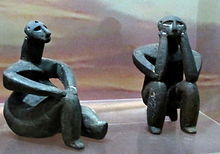
Remains of 34,950-year-old
The Neolithic-Age Cucuteni area in northeastern Romania was the western region of one of the earliest European civilizations, known as the Cucuteni–Trypillia culture.[4] The earliest-known salt works is at Poiana Slatinei near the village of Lunca; it was first used in the early Neolithic around 6050 BC by the Starčevo culture and later by the Cucuteni-Trypillia culture in the pre-Cucuteni period.[5]
Dacia
The Dacians, who are widely accepted to be the same people as the Getae, were a branch of Thracians who inhabited Dacia, which corresponds with modern Romania, Moldova, northern Bulgaria, south-western Ukraine, Hungary east of the Danube river and West Banat in Serbia.[6]
The earliest written evidence of people living in the territory of present-day Romania comes from Herodotus in Book IV of his Histories, written in c. 440 BC; He writes that the tribal union/confederation of the Getae were defeated by the Persian Emperor Darius the Great during his campaign against the Scythians.[7]
The Dacians are the most law-abiding and the bravest of the Thracians. They believe they are immortal, forever living in the following sense: they think they do not die and that the one who dies joins Zalmoxis, a divine being.
— Herodotus

The Dacians spoke a dialect of the Thracian language but were influenced culturally by the neighbouring Scythians in the east and by the Celtic invaders of Transylvania in the 4th century.
Due to the fluctuating nature of the Dacian states, especially before the time of Burebista and before the 1st century AD, the Dacians would often be split into different kingdoms. Known rulers of the Dacians include
The Dacia of King Burebista (82–44 BC) stretched from the Black Sea to the source of the river Tisa and from the Balkan Mountains to Bohemia.[33] During that period, the Geto-Dacians conquered a wider territory and Dacia extended from the Middle Danube to the Black Sea littoral (between Apollonia and Olbia) and from present-day Slovakia's mountains to the Balkan mountains.[34] In 53 BC, Julius Caesar stated that the lands of the Dacians started on the eastern edge of the Hercynian Forest (Black Forest).[35]
Geto-Dacians inhabited both sides of the Tisa river prior to the rise of the Celtic

A kingdom of Dacia also existed as early as the first half of the 2nd century BC under King
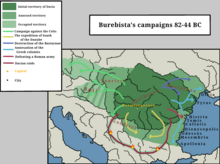
Burebista suppressed the indigenous minting of coinages by four major tribal groups, adopting imported or copied Roman denarii as a monetary standard.[36] During his reign, Burebista transferred the Geto-Dacian capital from Argedava to Sarmizegetusa Regia.[40][41] For at least one and a half centuries, Sarmizegetusa was the Dacians' capital and reached its peak under King Decebalus. The Dacians appeared so formidable that Caesar contemplated an expedition against them, which his death in 44 BC prevented. In the same year, Burebista was murdered, and the kingdom was divided into four (later five) parts under separate rulers.

The Dacians are often mentioned under Augustus, according to whom they were compelled to recognize Roman supremacy. However they were by no means subdued, and in later times to maintain their independence they seized every opportunity to cross the frozen Danube during the winter and ravaging the Roman cities in the province of Moesia.
Although the Getae and Daci once attained to very great power, so that they actually could send forth an expedition of two hundred thousand men, they now find themselves reduced to as few as forty thousand, and they have come close to the point of yielding obedience to the Romans, though as yet they are not absolutely submissive, because of the hopes which they base on the Germans, who are enemies to the Romans.
— Strabo

During the War of Actium, King Cotiso found himself courted by the two Roman antagonists, Octavian and Mark Antony. Cotiso was in a strong position to dictate terms of any alliance. Octavian/Augustus worried about the frontier and possible alliance between Mark Antony and the Dacians, and plotted an expedition against Dacia around 35 BC. Despite several small conflicts, no serious campaigns were mounted. King Cotiso chose to ally himself with Mark Antony. According to Alban Dewes Winspear and Lenore Kramp Geweke he "proposed that the war should be fought in Macedonia rather than Epirus. Had his proposal been accepted, the subjection of Antonius might have been less easily accomplished."[42]

According to
After Augustus's victory in the civil wars, the Romans punished the Dacian ruler, who was apparently defeated in battle around 25 BC.[45] In his account of his achievements as emperor, the Res Gestae, Augustus claimed that the Dacians had been subdued. This was not entirely true, because Dacian troops frequently crossed the Danube to ravage parts of Pannonia and Moesia.[46] He may have survived until the campaign of Marcus Vinicius in the Dacian area c.9 BC. Vinicius was the first Roman commander to cross the Danube and invade Dacia itself. Ioana A. Oltean argues that Cotiso probably died at some point during this campaign.[47] According to Jordanes Cotiso was succeeded by Comosicus, about whom nothing is known beyond the name.[47] King Scorilo was Comosicus' successor and may have been the father of Decebalus. The Roman historian Jordanes lists a series of Dacian kings before Decebalus, placing a ruler called "Coryllus" between Comosicus and the independently attested Duras, who preceded Decebalus as king. Coryllus is supposed to have presided over a long peaceful 40-year rule, however, the name Coryllus is not mentioned by any other historian, and it has been argued that it "is a misspelling of Scorilo, a relatively common Dacian name".[48] On this basis, Coryllus has been equated with the Scorilo named on an ancient Dacian pot bearing the words “Decebalus per Scorilo”. Though far from certain, this has also been translated as "Decebalus son of Scorilo". If so, this might mean that Decebalus was the son of Scorilo, with Duras possibly being either an older son or a brother of Scorilo.[49] A Dacian king (dux Dacorum) called Scorilo is also mentioned by Frontinus, who says he was in power during a period of turmoil in Rome.[50] From this evidence and references to Dacian kings elsewhere, it is suggested that Scorilo probably ruled from the 30s or 40s AD through to 69–70.[50]
The Dacians regularly raided into Roman territory in
King Duras ruled between the years AD 69 and 87, during the time that Domitian ruled the Roman Empire. He was one of a series of rulers following the Great King Burebista. Duras' immediate successor was Decebalus. Duras may be identical to the "Diurpaneus" (or "Dorpaneus") identified in Roman sources as the Dacian leader who, in the winter of 85, ravaged the southern banks of the Danube, which the Romans defended for many years. Many authors refer to him as "Duras-Diurpaneus".[53][54][55] Other scholars argue that Duras and Diurpaneus are different individuals, or that Diurpaneus is identical to Decebalus.[56]
The Roman governor of Moesia, Oppius Sabinus, raised an army and went to war with the Dacians following the Dacian (Getae) raids into Roman territory.[57] Diurpaneus and his people defeated and decapitated Oppius Sabinus. When news of the defeat reached Rome, the citizens became fearful that the conquering enemy would invade and spread destruction further into the Empire. Because of this fear, Domitian was obliged to move with his entire army into Illyria and Moesia, the latter of which was now split into Upper and Lower regions. He ordered his commander Cornelius Fuscus to cross the Danube.[57] The Dacians were pushed back across the Danube, but Fuscus suffered a crushing defeat when ambushed by "Diurpaneus". At this point, the probably elderly Duras seems to have peacefully ceded power to Decebalus.
King Decebalus ruled the Dacians between AD 87 and 106. The frontiers of Decebal's Dacia were marked by the Tisa River to the west, by the trans-Carpathians to the north and by the Dniester River to the east.[58]

From AD 85 to 89, the Dacians under
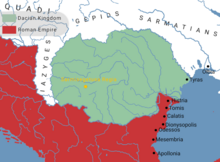
To increase the glory of his reign, restore the finances of Rome, and end a treaty perceived as humiliating, Trajan resolved on the conquest of Dacia, the capture of the famous Treasure of Decebalus, and control over the Dacian gold mines of
Decebalus rebuilt his power over the following years and attacked Roman garrisons again in AD 105. In response Trajan again marched into Dacia,
The weapon most associated with the Dacian forces that fought against Trajan's army during his invasions of Dacia was the falx, a single-edged scythe-like weapon. The falx was able to inflict horrible wounds on opponents, easily disabling or killing the heavily armored Roman legionaries.[71] Trajan erected the Column of Trajan in Rome to commemorate his victory.[72]
Roman Dacia (106–275 AD)

Roman Dacia, also known as Dacia Felix, was organized as an
While it is certain that colonists in large numbers were imported from all over the empire to settle in Roman Dacia,[74] this appears to be true for the newly created Roman towns only. The lack of epigraphic evidence for native Dacian names in the towns suggests an urban–rural split between Roman multi-ethnic urban centres and the native Dacian rural population.[74] On at least two occasions the Dacians rebelled against Roman authority: first in 117 AD, which caused the return of Trajan from the east,[75] and in 158 AD when they were put down by Marcus Statius Priscus.[76]
Some scholars have used the lack of civitates peregrinae in Roman Dacia, where indigenous peoples were organised into native townships, as evidence for the Roman depopulation of Dacia.[77] Prior to its incorporation into the empire, Dacia was a kingdom ruled by one king, and did not possess a regional tribal structure that could easily be turned into the Roman civitas system as used successfully in other provinces of the empire.[78]
As per usual Roman practice, Dacian males were recruited into auxiliary units[79] and dispatched across the empire.[80] The Vexillation Dacorum Parthica accompanied the emperor Septimius Severus during his Parthian expedition,[81] while the cohort I Ulpia Dacorum was posted to Cappadocia.[82] Others included the II Aurelia Dacorum in Pannonia Superior, the cohort I Aelia Dacorum in Roman Britain, and the II Augusta Dacorum milliaria in Moesia Inferior.[82] There are a number of preserved relics originating from cohort I Aelia Dacorum, with one inscription describing the sica, a distinctive Dacian weapon.[83] Numerous Roman military diplomas issued for Dacian soldiers discovered after 1990 indicate that veterans preferred to return to their place of origin;[84] per usual Roman practice, these veterans were given Roman citizenship upon their discharge.[85]
In an attempt to fill the cities, cultivate the fields, and mine the ore, a large-scale attempt at colonization took place with colonists coming in "from all over the Roman world".
The first settlement at Sarmizegetusa was made up of Roman citizens who had retired from their legions.[89] Based upon the location of names scattered throughout the province, it has been argued that a large percentage of colonists originated from Noricum and western Pannonia.[90] Specialist miners (the Pirusti tribesmen)[91] were brought in from Dalmatia.[92]

Although the Romans conquered and destroyed the ancient Kingdom of Dacia, much of the land remained outside of Roman Imperial authority. The conquest changed the balance of power in the region and was the catalyst for a renewed alliance of Germanic and Celtic tribes and kingdoms against the Roman Empire. However, the material advantages of the Roman Imperial system was attractive to the surviving aristocracy. Afterwards, many of the Dacians became Romanised (see also
According to
Even so, the Germanic and Celtic kingdoms, particularly the
The province was abandoned by Roman troops, and, according to the Breviarium historiae Romanae by Eutropius, Roman citizens "from the towns and lands of Dacia" were resettled to the interior of Moesia.[94] Under Diocletian, c. AD 296, in order to defend the Roman border, fortifications were erected by the Romans on both banks of the Danube.[95]
Constantinian reconquest of Dacia

In 328 the emperor
In 376 the region was conquered by
The Hellenic chronicle could possibly qualify to the first testimony of Romanians in Pannonia and Eastern Europe during the time of Attila,[102][103][104] implying that the formation of Proto-Romanian (or Common Romanian) from Vulgar Latin started in the 5th century.[105][106] The words "torna, torna fratre"[107] (return, return brother) recorded in connection with a Roman campaign across the Balkan Mountains by Theophylact Simocatta and Theophanes the Confessor evidence the development of a Romance language in the late 6th century.[108] The words were shouted "in native parlance"[109] by a local soldier in 587 or 588.[108][110] The 11th-century Persian writer, Gardizi, wrote about a Christian people "from the Roman Empire" called N.n.d.r, inhabiting the lands along the Danube.[111] He describes them as "more numerous than the Hungarians, but weaker".[111] Historian Adolf Armbruster identified this people as the Romanians.[111] Hungarian historiography identifies this people as the Bulgarians.[112]
Name
The Dacians were known as Geta (plural Getae) in Ancient Greek writings, and as Dacus (plural Daci) or Getae in Roman documents,[114] but also as Dagae and Gaete as depicted on the late Roman map Tabula Peutingeriana. It was Herodotus who first used the ethnonym Getae in his Histories.[115] In Greek and Latin, in the writings of Julius Caesar, Strabo, and Pliny the Elder, the people became known as 'the Dacians'.[116] Getae and Dacians were interchangeable terms, or used with some confusion by the Greeks.[117][118] Latin poets often used the name Getae.[119] Modern historians prefer to use the name Geto-Dacians.[116] Strabo describes the Getae and Dacians as distinct but cognate tribes. This distinction refers to the regions they occupied.[120] Strabo and Pliny the Elder also state that Getae and Dacians spoke the same language.[120][121]
By contrast, the name of Dacians, whatever the origin of the name, was used by the more western tribes who adjoined the
The ethnographic name Daci is found under various forms within ancient sources. Greeks used the forms Δάκοι "Dakoi" (
There are similarities between the ethnonyms of the Dacians and those of Dahae (Greek Δάσαι Δάοι, Δάαι, Δαι, Δάσαι Dáoi, Dáai, Dai, Dasai; Latin Dahae, Daci), an Indo-European people located east of the Caspian Sea, until the 1st millennium BC. Scholars have suggested that there were links between the two peoples since ancient times.[132][133][134][127] The historian David Gordon White has, moreover, stated that the "Dacians ... appear to be related to the Dahae".[135]
By the end of the first century AD, all the inhabitants of the lands which now form Romania were known to the Romans as Daci, with the exception of some
Carpi and Costoboci
The Carpi were a sizeable group of tribes, who lived beyond the north-eastern boundary of Roman Dacia. The majority view among modern scholars is that the Carpi were a North Thracian tribe and a subgroup of the Dacians.[136] However, some historians classify them as Slavs.[137] According to Heather, the Carpi were Dacians from the eastern foothills of the Carpathian range – modern Moldavia and Wallachia – who had not been brought under direct Roman rule at the time of Trajan's conquest of Transylvania Dacia. After they generated a new degree of political unity among themselves in the course of the third century, these Dacian groups came to be known collectively as the Carpi.[138]

The ancient sources about the Carpi, before 104 AD, located them on a territory situated between the western side of Eastern European Galicia and the mouth of the Danube.
The main view is that the Costoboci were ethnically Dacian.[146] Others considered them a Slavic or Sarmatian tribe.[147][148] There was also a Celtic influence, so that some consider them a mixed Celtic and Thracian group that appear, after Trajan's conquest, as a Dacian group within the Celtic superstratum.[149] The Costoboci inhabited the southern slopes of the Carpathians.[150] Ptolemy named the Coestoboci (Costoboci in Roman sources) twice, showing them divided by the Dniester and the Peucinian (Carpathian) Mountains. This suggests that they lived on both sides of the Carpathians, but it is also possible that two accounts about the same people were combined.[150] There was also a group, the Transmontani, that some modern scholars identify as Dacian Transmontani Costoboci of the extreme north.[140][151] The name Transmontani was from the Dacians' Latin,[citation needed] literally "people over the mountains". Mullenhoff identified these with the Transiugitani, another Dacian tribe north of the Carpathian mountains.[152]
Based on the account of
Culture
Body-painting was customary among the Dacians.[specify] It is probable that the tattooing originally had a religious significance.[157] They practiced symbolic-ritual tattooing or body painting for both men and women, with hereditary symbols transmitted up to the fourth generation.[158]
Dacian religion was considered by the classic sources as a key source of authority, suggesting to some that Dacia was a predominantly theocratic state led by priest-kings. However, the layout of the Dacian capital Sarmizegethusa indicates the possibility of co-rulership, with a separate high king and high priest.[36] Ancient sources recorded the names of several Dacian high priests (Deceneus, Comosicus and Vezina) and various orders of priests: "god-worshipers", "smoke-walkers" and "founders".[36] Both Hellenistic and Oriental influences are discernible in the religious background, alongside chthonic and solar motifs.[36] According to Herodotus' account of the story of Zalmoxis or Zamolxis,[115] the Getae (speaking the same language as the Dacians and the Thracians, according to Strabo) believed in the immortality of the soul, and regarded death as merely a change of country. Their chief priest held a prominent position as the representative of the supreme deity, Zalmoxis, who is called also Gebeleizis by some among them.[115][159] Strabo wrote about the high priest of King Burebista Deceneus: "a man who not only had wandered through Egypt, but also had thoroughly learned certain prognostics through which he would pretend to tell the divine will; and within a short time he was set up as god (as I said when relating the story of Zamolxis)".[160]

The Goth
Early Middle Ages


Between 271 and 275, the Roman army and administration left Dacia, which was invaded later by the
After the disintegration of
The Bulgarians' main rivals in the area were the
In 803,
High Middle Ages

During the
The
The
It is debated whether elements of the mixed Daco–Roman population survived in Transylvania through the
Several
King
was founded in 1346.Independent Wallachia had been near the border of the Ottoman Empire since the 14th century until it had gradually succumbed to the Ottomans' influence during the next centuries with brief periods of independence.
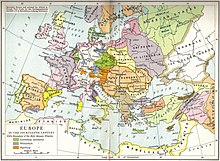
Although the core religious vocabulary of the Romanian language originated from Latin,[201] many terms were adopted from the Slavic Orthodoxy,[202] showing a significant influence dating from the Bulgarian Empire (681–1396).[203]
Early modern period

After the Battle of Mohács in 1526, Transylvania belonged to the Eastern Hungarian Kingdom, from which the Principality of Transylvania emerged in 1570 by the Treaty of Speyer.[204]
By 1541, the entire
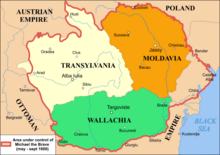
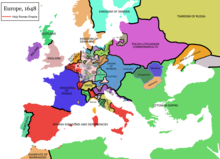

The
During the Austro-Hungarian rule of Transylvania, Romanians formed the majority of the population.[216][217] Nationality issues occurred between Hungarians and Romanians due to the Magyarization policy.[218]
After their defeat to the Russians, the Ottoman Empire restored the Danube ports of
Revolutions of 1848 and formation of modern Romania

In 1848, there was a
United Principalities of Moldavia and Wallachia
After the unsuccessful 1848 revolution, the
The aftermath of the
Negotiations amounted to an agreement on a minimal formal union, to be known as the United Principalities of Moldavia and Wallachia but with separate institutions and thrones and with each principality electing its own prince. However, the Moldavian and Wallachian elections for the ad-hoc divans in 1859 profited from an ambiguity in the text of the final agreement, which, while specifying two separate thrones, did not prevent the same person from occupying both thrones simultaneously and ultimately ushered in the ruling of Alexandru Ioan Cuza as Domnitor (Ruling Prince) over both Moldavia and Wallachia from 1859 onwards, uniting both principalities.[224]
Alexander Ioan Cuza carried out reforms including abolishing serfdom and started to unite the institutions one by one in spite of the convention from Paris. With help from unionists, he unified the government and parliament, effectively merging Wallachia and Moldavia into one country and in 1862 the country's name was changed to United Principalities of Romania.
Romania was created as a personal union that did not include Transylvania, where the upper class and the aristocracy remained mainly Hungarian, although Romanian nationalism clashed with Hungarian nationalism at the end of the 19th century.[citation needed][225] Austria-Hungary, especially under the Dual Monarchy of 1867, kept the territory firmly in control even in parts of Transylvania where Romanians constituted a vast majority.[citation needed]
Independence and Kingdom of Romania
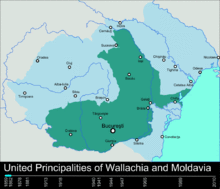
In an 1866 coup d'état,
The period between 1878 and 1914 was one of stability and progress for Romania. During the Second Balkan War, Romania joined Greece, Serbia and Montenegro against Bulgaria.[citation needed] In the Treaty of Bucharest of 1913, Romania gained Southern Dobruja and established the Durostor and Caliacra counties.[231]
The governments of Britain and the United States repeatedly protested the brutal treatment of Romanian Jews, who were regarded as aliens who had no civil or political rights. Romania engaged in arbitrary expulsions of Jews as vagabonds and tolerated violent pogroms against Jews, many of whom fled to the United States.[232][233]
World War I
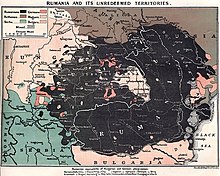
Due to Romania's unfavorable location between the
King Carol I died on 10 October 1914, and his successor,
On 4 August 1916, Romania and the Entente signed the Political Treaty and Military Convention, which established the parameters of Romania's participation in the war. The Allies promised to Romania the Austro-Hungarian regions of Bukovina, Transylvania up to Tisza river and all of Banat. Joining the Entente had large popular support.[239] The Romanian campaign plan (Hypothesis Z) consisted in attacking Austria-Hungary in Transylvania, while defending Southern Dobruja and Giurgiu from Bulgaria in the south.[240]

The German high command was seriously worried about the prospect of Romania entering the war, Paul von Hindenburg writing:
It is certain that so relatively small a state as Rumania had never before been given a role so important, and, indeed, so decisive for the history of the world at so favorable a moment. Never before had two great Powers like Germany and Austria found themselves so much at the mercy of the military resources of a country which had scarcely one twentieth of the population of the two great states. Judging by the military situation, it was to be expected that Rumania had only to advance where she wished to decide the world war in favor of those Powers which had been hurling themselves at us in vain for years. Thus everything seemed to depend on whether Rumania was ready to make any sort of use of her momentary advantage.[241]
On 27 August 1916, the Romanian Army launched an attack against Austria-Hungary, with limited Russian support. The Romanian offensive was initially successful and Romania managed to occupy 1/3rd of Transylvania, but when the German army arrived in Transylvania the Romanians began to be pushed back.[242] While on the southern front, a combined German-Bulgarian-Turkish offensive gradually occupied all of Dobruja and captured Giurgiu. The bulk of the Romanian army managed to escape encirclement from Giurgiu and retreated to Bucharest. As a result of the Battle of Bucharest, the Central Powers occupied Bucharest on 6 December 1916.[243]
In the summer of 1917, one of the largest concentrations of forces in World War I was present in Romania: 9 armies, 80 infantry divisions and 19 cavalry divisions, totaling 974 battalions, 550 squadrons and 923 artillery batteries. 800,000 combatants and 1,000,000 reservists were present.[244]
In 1917, a new Central Powers offensive began, leading to the battles of Mărăști, Mărășești, and Oituz, where the Romanian army managed to defeat the Central Powers offensives and take back some territory in a counter-offensive.[245][246] Romania lost over 27,000 men while Germany and Austria-Hungary lost over 60,000. Notably, the Romanian heroine Ecaterina Teodoroiu and German General Karl von Wenninger were killed at the end of the Battle of Mărășești.[247] However, shortly after the military victories, the October Revolution threw the Russian Empire out of the war leaving Romania alone on the Eastern Front, completely surrounded by the Central Powers. This forced Romania to drop out of the war, and it signed the Treaty of Bucharest with the Central Powers in May 1918.[248]

In 1939, General August von Mackensen would describe the Central Powers offensive from 1917 as following:
After fighting with the Rumanians in 1916, I thought the Rumanian army had disappeared, that it did not exist in 1917 when I had to make a new effort to conquer the rest of Rumania. But when the battles started in Mărășești, Mărăști, Oituz, I was told that in front of me was the Rumanian army that I was convinced had disappeared. But the Rumanian army has risen from its ashes like the Phoenix bird. The attacks on the bayonet scared everyone, and they were running, the Germans, who didn't usually run, this time they were running.[249]
Under the terms of the Treaty of Bucharest, Romania would lose all of Dobruja to Bulgaria, all the Carpathian passes to Austria-Hungary and would lease all of its oil reserves to Germany for 99 years.[250][251] However, the Central Powers recognized Romania's union with Bessarabia who had recently declared independence from the Russian Empire following the October Revolution and voted for union with Romania in April 1918.[252] The parliament signed the treaty, however King Ferdinand refused to sign it, hoping for an Allied victory on the western front.[248] In October 1918, Romania renounced the treaty and on 10 November 1918, one day before the German armistice, Romania reentered the war after the successful Allied advances on the Macedonian front and advanced in Transylvania. The next day, the Treaty of Bucharest was nullified by the terms of the Armistice of Compiègne.[253][254] Total Romanian deaths from 1914 to 1918, military and civilian, within contemporary borders, were estimated at 748,000.[255]
Transylvanian, Bukovinian and Bessarabian Romanians
In Austria-Hungary, ethnic Romanians entered the war from the very beginning, with hundreds of thousands of Transylvanian and Bukovinian Romanians being mobilized throughout the war. Although most Transylvanian Romanians were loyal to the Austro-Hungarian Empire, over time, reactionary sentiments emerged, especially after Romania joined the war in 1916. Many of the previously loyal soldiers decided that it was much better to risk their lives through desertion, rather than shoot their ethnical conationals.[256] According to studies made by the army of the Austro-Hungarian Empire, the dedication of the Romanian military to the interest of Austria-Hungary was reduced, only ethnic Italians of the same empire can compete with them for the last place in a ranking according to devotion to the state per 100 soldiers, out of about 300,000 Austro-Hungarian deserters, 150.000 were ethnic Romanians.[257]
The Austro-Hungarian Romanian prisoners of war in the Russian Empire would eventually form the
It is estimated that in the period 1914–1918 between 400,000 and 600,000 soldiers of Romanian origin fought on different fronts of Austria-Hungary, which represented a significant percentage of the Romanian ethnics who lived in those times in the Empire. In total, up to 150,000 Romanians were killed in action while fighting as part of the Austro-Hungarian Army.[256]
Greater Romania (1918–1940)

Before World War I, the union of Michael the Brave, who ruled over the three principalities with Romanian population (Wallachia, Transylvania and Moldavia) for a short period of time,[222] was viewed in later periods as the precursor of a modern Romania, a thesis which was argued with noted intensity by Nicolae Bălcescu. This theory became a point of reference for nationalists, as well as a catalyst for various Romanian forces to achieve a single Romanian state.[264] World War I played a crucial part in the development of Romanian national consciousness.
In 1918, the union of Romania with
The Romanian expression România Mare (Great or Greater Romania) refers to the Romanian state in the interwar period and to the territory Romania covered at the time. At that time, Romania achieved its greatest territorial extent, almost 300,000 km2 or 120,000 sq mi[267]), including all of the historic Romanian lands.[268]
Most of the claimed territories were granted to the

As a result of the
Upon the death of King
Iuliu Maniu, leader of the National Peasants' Party, engineered Carol's return on the basis of a promise that he would forsake his mistress Magda Lupescu, and Lupescu herself had agreed to the arrangement. However, it became clear upon Carol's first re-encounter with his former wife, Elena, that he had no interest in a reconciliation with her, and Carol soon arranged for Magda Lupescu's return to his side. Her unpopularity was to be a millstone around Carol's neck for the rest of his reign. Maniu and his National Peasant Party shared the same general political aims of the Iron Guard: both fought against the corruption and dictatorial policies of King Carol II and the National Liberal Party.[271]
The

As the 1930s progressed, Romania's already shaky democracy slowly deteriorated toward fascist dictatorship. The constitution of 1923 gave the king free rein to dissolve parliament and call elections at will; as a result, Romania was to experience over 25 governments in a single decade.
Increasingly, these governments were dominated by a number of
Already, the Iron Guard had embraced the politics of assassinations, and various governments had reacted more or less in kind. On December 10, 1933, Liberal prime minister
In December 1937, the king appointed LANC leader, the poet
In April 1938, King Carol had Iron Guard leader Corneliu Zelea Codreanu (aka "The Captain") arrested and imprisoned. On the night of 29–30 November 1938, Codreanu and several other legionnaires were killed while purportedly attempting to escape from prison.
The royal dictatorship was brief. On 7 March 1939, a new government was formed with Armand Călinescu as prime minister; on 21 September 1939, three weeks after the start of World War II, Călinescu, in turn, was also assassinated by legionnaires avenging Codreanu's murder.
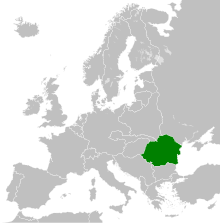
On 13 April 1939, France and the United Kingdom had pledged to guarantee the independence of the Kingdom of Romania. Negotiations with the Soviet Union concerning a similar guarantee collapsed when Romania refused to allow the Red Army to cross its frontiers.[274][275] In August 1939, Germany and the Soviet Union signed the Molotov–Ribbentrop Pact, which stipulated, among other things, the Soviet "interest" in Bessarabia. After the 1940 territorial losses and growing increasingly unpopular, Carol was compelled to abdicate and name general Ion Antonescu as the new Prime-Minister with full powers in ruling the state by royal decree.[276]
World War II and aftermath (1940–1947)
This section needs additional citations for verification. Please help improve this article by adding citations to reliable sources in this section. Unsourced material may be challenged and removed. (January 2022) (Learn how and when to remove this template message) |
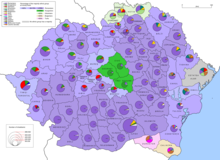
Eight days later Nazi Germany invaded the
Romania officially remained neutral and, under pressure from the Soviet Union and Germany, interned the fleeing Polish government after its members had crossed the Polish–Romanian border on 17 September, forcing them to relegate their authority to what became the

In 1940 Romania's territorial gains made following
Shortly thereafter, on 30 August, under the Second Vienna Award, Germany and Italy mediated a compromise between Romania and the Kingdom of Hungary: Hungary received a region referred to as 'Northern Transylvania', while 'Southern Transylvania' remained part of Romania. Hungary had lost Transylvania after World War I in the Treaty of Trianon. On 7 September, under the Treaty of Craiova, Southern Dobruja (which Bulgaria had lost after the Romanian invasion during the Second Balkan War in 1913), was ceded to Bulgaria under pressure from Germany. Despite the relatively recent acquisition of these territories, they were inhabited by a majority of Romanian speaking people (except Southern Dobruja), so the Romanians had seen them as historically belonging to Romania, and the fact that so much land was lost without a fight shattered the underpinnings of King Carol's power.
On 4 July,
In the immediate wake of the loss of Northern Transylvania, on 4 September the Iron Guard (led by Horia Sima) and General (later Marshal)
In power, the Iron Guard stiffened the already harsh antisemitic legislation, enacted legislation directed against minority businessmen and wreaked vengeance upon its enemies. On 8 October German troops began crossing into Romania. On 23 November Romania joined the Axis powers. On 27 November, 64 former dignitaries or officials were executed by the
The cohabitation between the Iron Guard and Antonescu was never an easy one. On 20 January 1941, the Iron Guard attempted a coup, combined with a pogrom against the Jews of Bucharest. Within four days, Antonescu had successfully suppressed the coup. The Iron Guard was forced out of the government. Sima and many other legionnaires took refuge in Germany;[279] others were imprisoned. Antonescu abolished the National Legionary State, in its stead declaring Romania a "National and Social State."
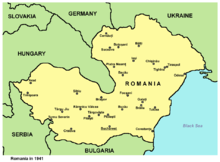

On 22 June 1941, German armies with Romanian support attacked the Soviet Union. German and Romanian units conquered Bessarabia, Odessa, and Sevastopol, then marched eastward across the Russian steppes toward Stalingrad. Romania welcomed the war because they were allies with Germany. Hitler rewarded Romania's loyalty by returning Bessarabia and northern Bukovina and by allowing Romania to administer Soviet lands immediately between the Dniester and the Bug, including Odessa and Nikolaev.
Romanian armies advanced far into the Soviet Union during 1941 and 1942 before being involved in the disaster at the Battle of Stalingrad in the winter of 1942–43. Petre Dumitrescu, one of Romania's most important generals, was commander of the Third Army at Stalingrad. In November 1942, the German Sixth Army was briefly put at Dumitrescu's disposal during a German attempt to relieve the Third Army following the devastating Soviet Operation Uranus. Prior to the Soviet counteroffensive at Stalingrad, the Antonescu government considered a war with Hungary over Transylvania an inevitability after the expected victory over the Soviet Union.[274]
King Michael's Coup
On 23 August 1944, with the Red Army penetrating German defenses during the
In a radio broadcast to the Romanian nation and army on the night of 23 August King Michael issued a cease-fire,
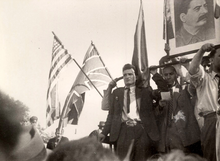
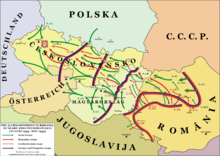
During the Moscow Conference in October 1944 Winston Churchill, Prime Minister of the United Kingdom, proposed an agreement to Soviet leader Joseph Stalin on how to split up Eastern Europe into spheres of influence after the war. The Soviet Union was offered a 90% share of influence in Romania.[290]
The Armistice Agreement of 12 September stipulated in Article 18 that "An Allied Control Commission will be established which will undertake until the conclusion of peace the regulation of and control over the execution of the present terms under the general direction and orders of the Allied (Soviet) High Command, acting on behalf of the Allied Powers". The Annex to Article 18 made clear that "The Romanian Government and their organs shall fulfil all instructions of the Allied Control Commission arising out of the Armistice Agreement." The Agreement also stipulated that the
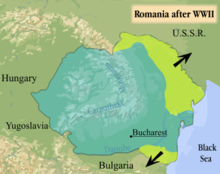
As the country declared war on Germany on the night of 23 August 1944, border clashes between Hungarian and Romanian troops erupted almost immediately. On 24 August, German troops attempted to seize Bucharest and suppress Michael's coup, but were repelled by the city's defenses, which received some support from the United States Air Force. Other Wehrmacht units in the country suffered severe losses: remnants of the Sixth Army retreating west of the
In early September, Soviet and Romanian forces entered Transylvania and captured the towns of
The
Under the
Communist period (1947–1989)
This section needs additional citations for verification. Please help improve this article by adding citations to reliable sources in this section. Unsourced material may be challenged and removed. (January 2022) (Learn how and when to remove this template message) |
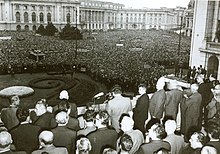

In Romania proper,
Romania was proclaimed a people's republic[295][296] and remained under military and economic control of the Soviet Union until the late 1950s. During this period, Romania's resources were drained by the "SovRom" agreements; mixed Soviet-Romanian companies were established to mask the Soviet Union's looting of Romania.[297][298][299]
Romania's leader from 1948 to his death in 1965 was
In 1946 and 1947, several high-ranking members in the pro-Axis government were executed as war criminals, primarily for their involvement in the Holocaust and for attacking the Soviet Union. Antonescu himself was executed 1 June 1946. Once the Communist government became more entrenched, the number of arrests increased. All strata of society were involved, but particularly targeted were the prewar elites, such as intellectuals, and anybody who could potentially form the nucleus of anti-Communist resistance. According to figures, in the years between 1945 and 1964, 73,334 people were arrested.[300] Between 60,000[301] and 80,000 political prisoners were detained.[302][303][304][305][306]
Gheorghiu-Dej attained greater independence for Romania from the Soviet Union by persuading Soviet First Secretary
Between 1977 and 1981, Romania's
Ceaușescu eventually initiated a project of full reimbursement of the foreign debt; to achieve this, he imposed
1989 Revolution
This section does not cite any sources. Please help improve this section by adding citations to reliable sources. Unsourced material may be challenged and removed. (January 2022) (Learn how and when to remove this template message) |
The
After being
Ion Iliescu, a former Communist Party official marginalized by Ceaușescu, attained national recognition as the leader of an impromptu governing coalition, the National Salvation Front (FSN) that proclaimed the establishment of democracy and civil liberties on 22 December 1989.[citation needed] The Communist Party was initially outlawed by Ion Iliescu, but he soon revoked that decision; as a consequence, Communism is not outlawed in Romania today. However, Ceaușescu's most controversial measures, such as bans on abortion and contraception, were among the first laws to be changed after the Revolution.[citation needed]
Transition to free market (1990–2004)
This section may lend create a more balanced presentation. Discuss and resolve this issue before removing this message. (January 2022) |
After the fall of Ceaușescu, the National Salvation Front (FSN) led by Ion Iliescu introduced partial multi-party democratic and free market measures.[313][314] A university professor with family roots in the Communist Party, Petre Roman, was named prime minister of the new government, which mostly consisted of former communist officials. The government initiated modest free market reforms. Several major political parties of the pre-war era, the National Christian Democrat Peasant's Party (PNȚ-CD), the National Liberal Party (PNL), and the Romanian Social Democratic Party (PSDR), were reconstituted.[315]
In April 1990, after several major political rallies that January), a sit-in protest questioning the legitimacy of the government began in University Square, Bucharest, organized by the main opposition parties. The protest became ongoing mass demonstration known as the Golaniad.[316] The protesters accused the FSN of being made up of former Communists and members of the Securitate. Presidential and parliamentary elections were held on 20 May 1990. Taking advantage of FSN's tight control of the national radio and television, Iliescu won 85% of the vote. The FSN secured two-thirds of the seats in Parliament. Though most protesters left University Square after the government gained a large parliamentary majority, a minority deemed the results undemocratic and demanded the exclusion from political life of the former high-ranking Communist Party members. The peaceful demonstrations degenerated into violence; some of the protesters attacked the police headquarters, national television station, and the Foreign Ministry. After the police failed to bring the demonstrators to order, Ion Iliescu called on the "men of good will" to defend the state institutions in Bucharest.[317][318]
Various worker groups from Romania's industrial platforms responded, some of them engaged in altercations with the protesters. The coal miners of the
New constitution
In December 1991, a new constitution was drafted and subsequently adopted, after a popular referendum, which, however, attracted criticism from international observers.[320] The constitution was most recently revised by a national referendum on 18–19 October 2003, and took effect on 29 October 2003.[321]
In March 1992, the FSN split into two groups: the
The subsequent disintegration of the National Salvation Front (FSN) produced the Party of Social Democracy in Romania (PDSR) (later Social Democratic Party, PSD), the Democratic Party (PD),[323] and the ApR (Alliance for Romania).[324] The PDSR party governed Romania from 1990 until 1996 through several coalitions and governments with Ion Iliescu as head of state.[citation needed]
Emil Constantinescu of the Democratic Convention (CDR) won the second round of the 1996 presidential election and replaced Iliescu as head of state.[325] The PDSR won the largest number of seats in the Parliament, but was unable to form a viable coalition. Constituent parties of the CDR joined the Democratic Party (PD) and the Democratic Alliance of Hungarians in Romania (UDMR/RMDSZ) to form a centrist coalition government, holding 60% of the seats in Parliament.[326]
This coalition implemented several critical reforms. The new coalition government, under prime minister Victor Ciorbea remained in office until March 1998, when Radu Vasile (PNȚ-CD) took over as prime minister. The former governor of the National Bank, Mugur Isărescu, eventually replaced Radu Vasile as head of the government.[citation needed]
The 2000 election brought Iliescu's PDSR, known as Social Democratic Party (PSD) after the merger with the PSDR, back to power.[323] Iliescu won a third term as the country's president. Adrian Năstase became the prime minister of the newly formed government.[327]
In 2004, Traian Băsescu was elected president with an electoral coalition called Justice and Truth Alliance (DA).[328] The government was formed by a larger coalition which also included the Conservative Party (PC) and the Democratic Alliance of Hungarians in Romania (UDMR).[329]
NATO and the European Union membership (2004–present)

Post–Cold War Romania developed closer ties with Western Europe, eventually joining NATO in 2004.[330]
Presidential and parliamentary elections took place again on 28 November 2004. No political party secured a viable parliamentary majority and opposition parties alleged the PSD had committed large-scale electoral fraud.[331] There was no winner in the first round of the presidential elections. The joint PNL-PD candidate Traian Băsescu won the second round on 12 December 2004 with 51% of the vote and became the third post-revolutionary president of Romania.[328][332]
The then PNL leader,
In June 1993, the country applied for membership in the European Union (EU). It became an Associated State of the EU in 1995, an Acceding Country in 2004, and a full member on 1 January 2007.[334]
Following the free travel agreement and politic of the post–Cold War period, as well as hardship of the life in the post 1990s economic depression, Romania has an increasingly large diaspora. The main emigration targets have been Italy, Germany, Spain, the United Kingdom, the United States and Hungary.[335]
In 2009, President Traian Basescu was re-elected for a second five-year term as the President.[336]
In January 2012, Romania experienced national protests, which were the first significant popular uprising in the country since 1991. They were triggered by proposed health reforms, and were further motivated by wider disillusionment with austerity and the government.[337][338]
In 2014, Klaus Iohannis was elected as the President of Romania,[339] and he was re-elected by a landslide victory in 2019.[340]
In December 2020,
In November 2021, Nicolae Ciucă became Romania's new prime minister. He formed a coalition government between former arch rivals, his own center-right National Liberal Party (PNL) and center-left Social Democratic Party (PSD).[343] On 15 June 2023, Marcel Ciolacu (PSD) was sworn in as the new Romanian Prime Minister. Rotating premiership had been long agreed as part of a deal by the ruling coalition.[344]
Romanian rulers
- List of Wallachian rulers(up to 1859)
- List of Moldavian rulers(up to 1859)
- List of Transylvanian rulers(up to 1867)
- Domnitori of Romania (1862–1881)
- Kings of Romania(1881–1947)
- Presidents of Romania(since 1974)
- Prime ministers of Romania (since 1862)
See also
- Balkan–Danubian culture
- Bulgarian lands across the Danube
- Historical regions of Romania
- King of Romania
- List of Dacian kings
- List of heads of government of Romania
- List of presidents of Romania
- List of wars involving Romania
- Military history of Romania
- Politics of Romania
- Territorial evolution of Romania
Notes
- ^ Dioscorides's book (known in English by its Latin title De Materia Medica ("Regarding Medical Materials")) has all the Dacian names of the plants preceded by Δάκοι Dakoi i.e. Δάκοι Dakoi προποδιλα Latin Daci propodila "Dacians propodila"
- ^ Extensive discussion of whether the date is 429 or 413 BC was reviewed and newly analyzed in Christopher Planeaux, "The Date of Bendis' Entry into Attica" The Classical Journal 96.2 (December 2000:165–192). Planeaux offers a reconstruction of the inscription mentioning the first introduction, p
- ^ Fifth-century fragmentary inscriptions that record formal descrees regarding formal aspects of the Bendis cult, are reproduced in Planeaux 2000:170f
References
- ^ Stoleru, Ciprian (13 September 2018). "Romania during the period of neutrality". Europe Centenary. Retrieved 4 March 2020.
- PMID 14580595, archived from the original(PDF) on 2007-09-25
- ]
- ^ John Noble Wilford (1 December 2009). "A Lost European Culture, Pulled From Obscurity". The New York Times (30 November 2009).
- ^ Patrick Gibbs. "Antiquity Vol 79 No 306 December 2005 The earliest salt production in the world: an early Neolithic exploitation in Poiana Slatinei-Lunca, Romania Olivier Weller & Gheorghe Dumitroaia". Antiquity.ac.uk. Archived from the original on 30 April 2011. Retrieved 2012-10-12.
- ISBN 978-963-386-004-5. Retrieved 2020-05-25 – via translate.google.com.
- ^ Herodotus (1859) [440 BCE, translated 1859], The Ancient History of Herodotus (Google Books), William Beloe (translator), Derby & Jackson, pp. 213–217, retrieved 2008-01-10
- ^ Atlas of Classical History by R. Talbert, 1989, page 63, "Getae under Cothelas"
- ^ https://revistapontica.files.wordpress.com/2012/02/pontica-3-pag-125-129.pdf Radu Ocheșeanu: Monedele basileului Moskon aflate în colecțiile Muzeului de Arheologie Constanța
- ^ Dacia: Landscape, Colonization and Romanization by Ioana A Oltean, 2007, Index Dromichaetes King of the Getians
- ^ McGing B.C.: The foreign policy of Mithridates VI Eupator, King of Pontus
- ISBN 9780880333450, page 17 "..Two inscriptions discovered at Histria indicate that Geto-Dacian rulers (Zalmodegikos and later Rhemaxos) continued to exercise control over that city-state around 200 BC ...."
- ^ The Hellenistic Age from the Battle of Ipsos to the Death of Kleopatra VII by Stanley M. Burstein, 1985, Index Rhemaxos Getic or Scythian ruler
- ISBN 9780880333450, page 17 "Two inscriptions discovered at Histria indicate that Geto-Dacian rulers (Zalmodegikos and later Rhemaxos) continued to exercise control over that city-state around 200 BC ...."
- ^ Dacia: Landscape, Colonization and Romanization by Ioana A Oltean, 2007, Index Rubobostes Dacian King
- ISBN 978-0-19-517072-6. Retrieved 22 December 2013.
- ^ Dacia: Landscape, Colonization and Romanization by Ioana A Oltean, 2007, page 53, "Dacian King Oroles"
- ^ Dacia: Landscape, Colonization and Romanization by Ioana A Oltean, 2007, page 47, "Dicomes of the Getians"
- ^ The Roman History: The Reign of Augustus by Cassius Dio, Ian Scott-Kilvert, and John Carter, 1987, page 85: "... Then he completed their destruction with the help of Roles, the king of a tribe of the Getae. When Roles visited Octavian, he was treated as a friend ..."
- ^ Cassius Dio. Roman History, Book LI. "While he was thus engaged, Roles, who had become embroiled with Dapyx, himself also king of a tribe of the Getae, sent for him. Crassus went to his aid, and by hurling the horse of his opponents back upon their infantry he so thoroughly terrified the latter also that what followed was no longer a battle but a great slaughter of fleeing men of both arms. Next he cut off Dapyx, who had taken refuge in a fort, and besieged him. In the course of the siege someone hailed him from the walls in Greek, obtained a conference with him, and arranged to betray the place. The barbarians, thus captured, turned upon one another, and Dapyx was killed along with many others. His brother, however, Crassus took alive, and not only did him no harm but actually released him."
- ^ Dacia: Landscape, Colonization and Romanization by Ioana A Oltean, 2007, page 146, "Zyraxes who ruled in Dobruja"
- ^ Studies in Ancient Greek and Roman Society by Robin Osborne, 2004, page 128: "... of its citizens, named Akornion, went on an embassy to Burebista, the first and greatest of the kings in Thrace..."
- ^ Dacia: Landscape, Colonization and Romanization by Ioana A Oltean, 2007, Index (Decaeneus/Dekaineus/Dicineus) Dacian High priest"
- ^ Berciu 1981, p. 139-140.
- ^ Dacia: Landscape, Colonization and Romanization by Ioana A Oltean, 2007, page 48, "The Dacian king Cotiso"
- ^ a b Dacia: Landscape, Colonization and Romanization by Ioana A Oltean, 2007, page 72, "At least two of his successors Comosicus and Scorillo/Corilus/Scoriscus became high priests and eventually Dacian kings"
- ^ a b Dacia: Landscape, Colonization and Romanization by Ioana A Oltean, 2007, page 47, "Kings Coson (who minted his own coins) and Duras"
- ^ De Imperatoribus Romanis [1]. Retrieved 2007-11-08. "In the year 88, the Romans resumed the offensive. The Roman troops were now led by the general Tettius Iulianus. The battle took place again at Tapae but this time the Romans defeated the Dacians. For fear of falling into a trap, Iulianus abandoned his plans of conquering Sarmizegetuza and, at the same time, Decebalus asked for peace. At first, Domitian refused this request, but after he was defeated in a war in Pannonia against the Marcomanni (a Germanic tribe), the emperor was obliged to accept the peace."
- ^ Wilhelm Tomachek in “Les restes de la langue dace” published in “Le Muséon By Société des lettres et des sciences, Louvain, Belgium, page 407 "Pieporus, prince des daces Costoboces..."
- ^ Gudmund Schütte in Ptolemy's maps of northern Europe, H. Hagerup, 1917 page 82 "historical king Pieporus. The same author Schütte in “Our forefathers” published by University Press, 1929 page 74 "The North Dacian tribes of the Koistobokoi and Karpoi unlike the rest of Dacia escaped the Roman conquest of AD 105..."
- ^ Wilhelm Tomachek (1883): “Les restes de la langue dace” published in “Le Muséon By Société des lettres et des sciences, Louvain, Belgium, page 409
- ISBN 978-0-19-814936-1, page 366
- ^ "History of Romania – Antiquity – The Dacians". Encyclopædia Britannica. 27 May 2023.
- ^ Murray 2001, p. 1120.
- ^ a b Mountain 1998, p. 59.
- ^ a b c d e f Taylor 2001, p. 215.
- ^ Barry Cunliffe (1987)142
- ^ "Justin: Epitome of the Philippic History of Pompeius Trogus, Book 32". forumromanum.org.
- ^ Strabo, Geography, VII:3.11
- ^ MacKendrick 2000, p. 48.
- ^ Goodman & Sherwood 2002, p. 227.
- ^ Alban Dewes Winspear, Lenore Kramp Geweke, Augustus and the Reconstruction of Roman Government and Society, University of Wisconsin Press, 1935 p.252.
- ^ Translations and reprints from the original sources of history, Univ. of Pennsylvania Press, 1898 , University of Pennsylvania. Dept. of History
- ^ a b Monumentum ancyranum: the deeds of Augustus, Volume 5, Issue 2, Augustus (Emperor of Rome) The Department of History of the University of Pennsylvania, 1898, page 73
- ^ William Miller, The Balkans: Roumania, Bulgaria, Servia, and Montenegro, Putnam, 1972, p.5
- ISBN 978-0195102338
- ^ a b Ioana A. Oltean, Dacia: Landscape, Colonization and Romanization, Routledge, 7 Aug 2007, p49.
- ^ Köpeczi, Béla, History of Transylvania: From the beginnings to 1606, Social Science Monographs, 2001, p.52.
- ^ Ion Grumeza, Dacia: Land of Transylvania, Cornerstone of Ancient Eastern Europe, University Press of America, 2009, p.72.
- ^ a b Bărbulescu, Mihai, et al, The History of Transylvania: (Until 1541), Romanian Cultural Institute, 2005, pp.87–9.
- ^ Ion Grumeza, Dacia: Land of Transylvania, Cornerstone of Ancient Eastern Europe, University Press of America, 2009, p.154-5.
- ^ Ioana A. Oltean, Dacia: Landscape, Colonization and Romanization, Routledge, 7 Aug 2007, p49.
- Walter de Gruyter, 1979, p.167.
- ^ Constantin Olteanu, The Romanian armed power concept: a historical approach, Military Publishing House, 1982, p.39.
- ^ Romania: Pages of History, Volume 4, Agerpres Publishing House, 1979, p.75.
- ^ Ioana A. Oltean, Dacia: Landscape, Colonization and Romanization, Routledge, 2007, p.49-50.
- ^ a b Brian W. Jones, The Emperor Domitian, Routledge, London, 1992, p.138
- ^ Vico & Pinton 2001, p. 325.
- ^ Westropp 2003, p. 104.
- ^ Matyszak 2004, p. 216.
- ^ Luttwak 1976, p. 53.
- ^ Matyszak 2004, p. 217.
- Diurpaneus(see Manea, p.109), but after this victory he was called Decebalus (the brave one).
- ^ Matyszak 2004, p. 219.
- ^ Goldsworthy 2004, p. 329.
- ^ Matyszak 2004, p. 222.
- ^ Matyszak 2004, p. 223.
- ^ Luttwak 1976, p. 54.
- ^ Stoica 1919, p. 52.
- ^ Luttwak 1976, p. 39.
- ^ Schmitz 2005, p. 30.
- ^ Sinnegen & Boak. A History of Rome to A.D. 565, Sixth Ed. MacMillan Publishing Co., New York. ç1977 p.312
- ^ Köpeczi 1994, p. 92.
- ^ a b Ellis 1998, pp. 220–237.
- ^ Pop 1999, p. 22.
- ^ Parker 1958, pp. 12–19.
- ^ Vékony 2000, p. 110.
- ^ Oltean 2007, p. 227.
- ^ Goldsworthy 2003, p. 76.
- ^ Köpeczi 1994, p. 102.
- ^ Vékony 2000, p. 109.
- ^ a b Găzdac 2010, p. 59.
- ^ Vékony 2000, p. 108.
- ^ Dana & Matei-Popescu 2009, pp. 234–235.
- ^ Erdkamp 2010, p. 442.
- ^ Pop 1999, p. 23.
- ^ a b Georgescu 1991, p. 6.
- ^ Köpeczi 1994, p. 106.
- ^ Köpeczi 1994, p. 103.
- ^ Köpeczi 1994, p. 104.
- ^ Köpeczi 1994, p. 79.
- ^ MacKendrick 2000, p. 206.
- ^ "Of the Manner in which the persecutors died" by Lactantius (early Christian author AD 240–320)
- ^ EUTROPIUS. "Eutropius, Abridgment of Roman History (Historiae Romanae Breviarium)". www.ccel.org. Archived from the original on 2009-02-20. Retrieved 2008-06-17.
- ^ Odahl 2003.
- ISBN 978-973-8966-70-3, p.64 -126
- ^ Heather, Peter (1996). The Goths. Blackwell Publishers. pp. 62, 63.
- ISBN 978-0-674-16531-1. p 250.
- ISBN 978-973-8966-70-3, p.64-126
- ^ Costin Croitoru, (Romanian) Sudul Moldovei în cadrul sistemului defensiv roman. Contribuții la cunoașterea valurilor de pământ. Acta terrae septencastrensis, Editura Economica, Sibiu 2002, ISSN 1583-1817, p.111.
- ISBN 0-415-38655-1, p.261.
- ^ Dvoichenko-Markov, Demetrius. "THE RUSSIAN PRIMARY CHRONICLE AND THE VLACHS OF EASTERN EUROPE". Byzantion, vol. 49, 1979, pp. 175–187. JSTOR, www.jstor.org/stable/44172681. Accessed 3 April 2020.
- ^ O. V. Tvorogov, Drevne-Russkie Chronography (Ancient Russian Chronographies), Leningrad, 1975, p.138.
- ^ P. P. Panaitescu, Introducere la Istoria Culturii Romànesti (Introduction to the History of Rumanian Culture), Bucharest, 1969, p. 130
- ^ Pană Dindelegan 2013, p. 2.
- ^ Petrucci 1999, p. 4.
- ^ The Chronicle of Theophanes Confessor (258.10–21.), p. 381.
- ^ a b Opreanu 2005, p. 129.
- ^ The History of Theophylact Simocatta (ii. 15.10.), p. 65.
- ^ Vékony 2000, pp. 206–207.
- ^ a b c Armbruster 1972, p. 11.
- ^ Kristó 1996, p. 63.
- ^ Millar 2004, p. 189: "the Getae over the Danube, whom they call Dacians"
- ^ Appian & 165 AD, Praef. 4/14-15, quoted in [113]
- ^ a b c Herodotus & 440 BC, 4.93–4.97.
- ^ a b c Fol 1996, p. 223.
- Trogus Pompeius"Daci quoque suboles Getarum sunt"
- ^ a b Crossland & Boardman 1982, p. 837.
- ^ Roesler 1864, p. 89.
- ^ a b Bunbury 1979, p. 150.
- ^ Oltean 2007, p. 44.
- ^ Bunbury 1979, p. 151.
- ^ a b Strabo & 20 AD, VII 3,12.
- ^ Garašanin, Benac (1973) 243
- ^ Parvan, Vulpe & Vulpe 2002, p. 158.
- ^ Tomaschek 1883, p. 397.
- ^ a b c Van Den Gheyn 1886, p. 170.
- ^ Mulvin 2002, p. 59: "…A tombstone inscription from Aquincum reads M. Secundi Genalis domo Cl. Agrip /pina/ negotiat. Dacisco. This is of a second century date and suggests the presence of some Dacian traders in Pannonia…"
- ^ Petolescu 2000, p. 163: "…patri incom[pa-] rabili, decep [to] a Daciscis in bel- loproclio …"
- ^ Dobiáš 1964, p. 43: "...CIL V 3372 inscription at Verona Papirio Marcellino, decepto a Daciscis in bello proelio.."
- ^ Gibbon 2008, p. 313: "…Aurelian calls these soldiers Hiberi, Riparienses, Castriani, and Dacisci " conform to "Vopiscus in Historia Augusta XXVI 38"
- ^ Kephart 1949, p. 28: The Persians knew that the Dahae and the other Massagetae were kin of the inhabitants of Scythia west of the Caspian Sea.
- ^ Chakraberty 1948, p. 34: "Dasas or Dasyu of the RigVeda are the Dahae of Avesta, Daci of the Romans, Dakaoi (Hindi Dakku) of the Greeks"
- ^ Pliny (the Elder) & Rackham 1971, p. 375.
- ^ White 1991, p. 239.
- ^ * Goffart 2006, p. 205
- Bunson 1995, p. 74
- MacKendrick 2000, p. 117
- Parvan & Florescu 1982, p. 136
- Burns 1991, pp. 26 and 27
- Odahl 2003, p. 19
- Waldman & Mason 2006, p. 19
- Millar 1970
- ^ Waldman & Mason 2006, p. 129.
- ^ Heather 2010, p. 114.
- ^ Pârvan 1926, p. 239.
- ^ a b Schütte 1917, p. 100.
- ^ Russu 1969, pp. 114–115.
- ^ Tomaschek 1883, p. 403.
- ^ Goffart 2006, p. 205.
- ^ Minns 2011, p. 124.
- ^ Nixon & Saylor Rodgers 1995, p. 116.
- ^ * Heather 2010, p. 131
- Waldman & Mason 2006, p. 184
- Poghirc 1989, p. 302
- Pârvan 1928, pp. 184 and 188
- Nandris 1976, p. 729
- Oledzki 2000, p. 525
- Astarita 1983, p. 62
- ^ a b Hrushevskyi 1997, p. 100.
- ^ Waldman & Mason 2006, p. 184.
- ^ Nandris 1976, p. 729.
- ^ a b Hrushevskyi 1997, p. 98.
- ^ Parvan & Florescu 1982, p. 135.
- ^ Schütte 1917, p. 18.
- ^ Heather 2010, p. 131.
- ^ Tomaschek 1883, p. 407.
- ^ Schütte 1917, p. 143.
- ^ Russu 1969, pp. 99, 116.
- ^ Bury et al. 1954, p. 543.
- ^ Oltean 2007, p. 114.
- ^ Histories by Herodotus Book 4 translated by G. Rawlinson
- ^ Strabo & 20 AD, VII 3,11.
- ^ Tomaschek 1893.
- ^ "BENDIS - Thracian Goddess of the Moon & Hunting". www.theoi.com.
- ^ Jordanes (551), Getica, sive, De Origine Actibusque Gothorum, Constantinople
- ^ Iliescu, Vl.; Paschale, Chronicon (1970), Fontes Historiae Daco-Romanae, vol. II, București, pp. 363, 587
{{citation}}: CS1 maint: location missing publisher (link) - ^ a b Teodor, Dan Gh. (1995), Istoria României de la începuturi până în secolul al VIII-lea, vol. 2, București, pp. 294–325
{{citation}}: CS1 maint: location missing publisher (link) - ^ Bóna, Istvan (2001), "The Kingdom of the Gepids", in Köpeczi, Béla (ed.), History of Transylvania: II.3, vol. 1, New York: Institute of History of the Hungarian Academy of Sciences,
Several migrating peoples lived alongside the local populations, such as the Gothic Empire (Oium) (from 271 until 378), the Hunnish Empire (until 435), the Avar Empire and the Slavs (during the 6th century)
- ^ Bóna, István (2001), "The Period of the Avar Rule", in Köpeczi, Béla (ed.), History of Transylvania: II.4, vol. 1, New York: Institute of History of the Hungarian Academy of Sciences
- ISBN 978-0-472-08149-3.
Second, another son, Isperikh (or Asparukh) moved into what is now Bessarabia, and then in the 670s crossed the Danube into Bulgaria. He conquered the Slavic tribes there and eventually established a Bulgarian state.
- ISBN 9789047423560.
The Bulgars following Kubrat's third son, Asparukh, migrated to the west, across the Dnieper and Dniester rivers. They settled in an area close to the Danube Delta named Onglos.
- ISBN 978-90-04-16389-8.
...date kuvrat's death between 650 and 665...
- ISBN 978-90-04-40993-4.
- ^ "T. Balkanski – Transilvanskite bylgari – Predgovor". macedonia.kroraina.com.
- ^ a b Opreanu 2005, p. 127.
- ^ a b Spinei 2009, p. 87.
- ^ Плиска-Преслав: Прабългарската култура, Том 2, Българска академия на науките Археологически институт и музей, 1981.
- Constantine VII, Porphyrogenitus (950), Constantine Porphyrogenitus De Administrando Imperio, Constantinople
- ^ Xenopol, Alexandru D. (1896), Histoire des Roumains, vol. i, Paris, p. 168
{{citation}}: CS1 maint: location missing publisher (link) - ^ Ștefănescu, Ștefan (1991), Istoria medie a României, vol. I, Bucharest, p. 114
{{citation}}: CS1 maint: location missing publisher (link) - ^ Predescu, Lucian (1940), Enciclopedia Cugetarea
- ^ "Pechenegs | people | Britannica.com". britannica.com. Retrieved 2015-08-25.
- ^ "Cumans and Tatars – Cambridge University Press". cambridge.org. Retrieved 2015-08-25.
- ^ eliznik. "Romania's ethnographic regions – Wallachia (Țara Românească)". eliznik.org.uk. Archived from the original on 2015-09-23. Retrieved 2015-08-25.
- ^ "Gather.com – Join The Conversation : Gather.com". gather.com. Archived from the original on 2013-04-26. Retrieved 2015-08-25.
- ^ István Lázár: Transylvania, a Short History, Simon Publications, Safety Harbor, Florida, 1996 [2][permanent dead link]
- ^ Martyn C. Rady: Nobility, Land and Service in Medieval Hungary, Antony Grove Ltd, Great Britain, 2000 [3]
- JSTOR 24363369.
- ^ György Fejér, Codex diplomaticus Hungariae ecclesiasticus ac civilis, Volume 7, typis typogr. Regiae Vniversitatis Vngaricae, 1831 [4]
- ^ a b c Tamás Kis, Magyar nyelvjárások, Volumes 18–21, Nyelvtudományi Intézet, Kossuth Lajos Tudományegyetem (University of Kossuth Lajos). Magyar Nyelvtudományi Tanszék, 1972, p. 83 Magyar nyelvjárások</
- ^ Dennis P. Hupchick, Conflict and chaos in Eastern Europe, Palgrave Macmillan, 1995 p. 58 [5]
- ^ István Vásáry, Cumans and Tatars: Oriental military in the pre-Ottoman Balkans, 1185–1365, Cambridge University Press, 2005, p. 28 [6][permanent dead link]
- ^ Heinz Stoob, Die Mittelalterliche Städtebildung im südöstlichen Europa, Böhlau, 1977, p. 204 [7]
- ^ a b Kristó 1988, pp. 96–97.
- ^ Bertényi 1989, p. 58.
- ISBN 0-88033-479-7.
- ^ Sălăgean 2005, p. 199.
- ISBN 0-300-04714-2
- ^ "VLAD TEPES – The Historical Dracula". donlinke.com. Archived from the original on 2015-09-02. Retrieved 2015-08-25.
- ^ Count Dracul's Legend, 2006, archived from the original on 2016-01-17
- ^ Marek, Miroslav, Rulers of Moldavia: Mushati family[self-published source]
- ^ Orthodox Church in America, St. Stephen the Great – Commemorated on July 2
- ^ Treptow et al. 1997, p. 45.
- ^ Spinei 2009, p. 269.
- ISBN 978-0-8156-2440-0
- ^ Köpeczi, Béla, ed. (2001), History of Transylvania: IV. The First Period of the Principality of Transylvania (1526–1606), vol. 1, New York: Institute of History of the Hungarian Academy of Sciences
- ISBN 978-0-19-878937-6.
- ISBN 978-1-4438-6686-6.
- ^ Rezachevici, Constantin (2000), "Mihai Viteazul: itinerariul moldovean", Magazin Istoric (in Romanian) (5), archived from the original on April 16, 2009
- ISBN 978-0-88033-491-4. Retrieved 2017-07-10.
- ^ Peter F. Sugar. "Southeastern Europe Under Ottoman Rule, 1354–1804" (History of East Central Europe), University of Washington Press, July 1983, page 163
- ^ Paul Lendvai, Ann Major. The Hungarians: A Thousand Years of Victory in Defeat C. Hurst & Co. Publishers, 2003, page 146;
- ISBN 978-1-55383-178-5.
- ^ "Transylvania" (2009). Encyclopædia Britannica. Retrieved July 7, 2009
- ^ "Diploma Leopoldinum" (2009). Encyclopædia Britannica. Retrieved July 7, 2009
- ISBN 978-90-04-33544-8.
- ^ Bessarabia. London, England: H.M. Stationery Office. 1920. p. 51.
- ^ Kocsis, Karoly; Kocsis-Hodosi, Eszter (1999), Ethnic structure of the population on the present territory of Transylvania (1880–1992), archived from the original on 2008-02-22
- ]
- ^ The Magyarization Process, GenealogyRO Group
- ISBN 978-1-107-00750-5.
- ^ Ivan, Cristi. "Romanian history the DACIA" (paper).
- ^ Iván T. Berend, History Derailed: Central and Eastern Europe in the Long Nineteenth Century, University of California Press, 2013, p. 112 and p. 252
- ^ a b Juliana Geran Pilon, The Bloody Flag: Post-Communist Nationalism in Eastern Europe : Spotlight on Romania , Transaction Publishers, 1982, p. 56
- ISBN 978-0-914710-51-6
- ISBN 978-0-295-80360-9. Retrieved 2012-03-28.
- ^ "The Identity conflict of the sango minority of Romania" (PDF).
- ^ San Stefano Preliminary Treaty (in Russian), 1878
- ^ Modern History Sourcebook: The Treaty of Berlin, 1878 – Excerpts on the Balkans, Berlin, 13 July 1878, archived from the original on 8 June 2008, retrieved 30 August 2008
{{citation}}: CS1 maint: location missing publisher (link) - doi:10.3138/cjh.31.2.329, archived from the originalon March 24, 2008
- ^ "Internet History Sourcebooks: Modern History". sourcebooks.fordham.edu. Retrieved 2023-02-02.
- ^ "kingdom of romania". kcdogs.com. Retrieved 2021-07-21.[permanent dead link]
- ^ Anderson, Frank Maloy; Hershey, Amos Shartle (1918), Handbook for the Diplomatic History of Europe, Asia, and Africa 1870–1914, Washington D.C.: Government Printing Office
- ISBN 978-1-136-15895-7.
- ^ Satu Matikainen, Great Britain, British Jews and the international protection of Romanian Jews, 1900–1914: a study of Jewish diplomacy and minority rights (University of Jyväskylä, 2006).
- ISBN 978-0-8108-5820-6. Retrieved 2014-03-02.
- ISBN 978-1-4051-2386-0. Retrieved 2014-03-02.
- ISBN 978-0-8108-5820-6. Retrieved 2014-03-02.
- ISBN 978-1-4051-2386-0. Retrieved 2014-03-02.
- ^ Marcel Mitrasca, Moldova: A Romanian Province under Russian Rule. Diplomatic History from the Archives of the Great Powers, pg. 56
- ^ Laurentiu-Cristian Dumitru, Preliminaries of Romania's entering the World War I, No. 1/2012, Bulletin of "Carol I" National Defence University, Bucharest, p.171
- ^ Torrie, Glenn E. (Spring 1978). "Romania's Entry into the First World War: The Problem of Strategy" (PDF). Emporia State Research Studies. 26 (4). Emporia State University: 7–8.
- ^ Paul von Hindenburg, Out of My Life, Vol. I, trans. F.A. Holt (New York: Harper & Brothers, 1927), 243.
- ^ Michael B. Barrett, Prelude to Blitzkrieg: The 1916 Austro-German Campaign in Romania (2013)
- ^ România în anii primului război mondial, vol.2, p. 831
- ^ România în anii primului război mondial, vol. 2, Ed. Militară, Bucharest, 1987
- ^ România în anii primului război mondial, vol. 2, pp. 834–835
- ^ Sanders Marble, Brill, 2016, King of Battle: Artillery in World War I, pp. 343–349
- ^ Keith Hitchins, Clarendon Press, 1994, Rumania 1866–1947, p. 269
- ^ a b John Keegan, World War I, pg. 308
- ^ Ioan Scurtu, Octavian Silivestru, Oral History Archive, 1994
- ^ "Article X of the Treaty". Archived from the original on 24 March 2019. Retrieved 17 September 2017.
- ^ United States Department of State (1918). Texts of the Roumanian "Peace". Washington Government Printing Office.
- ISBN 978-0-415-05346-4, p. 24–25
- ^ Béla, Köpeczi. Erdély története. Akadémiai Kiadó.
- ISBN 978-84-8371-020-3.
- ISBN 978-5-93165-107-1.
- ^ a b Erlikman, Vadim (2004). Poteri narodonaseleniia v XX veke : spravochnik. Moscow. Page 51
- ^ a b Volantini di guerra: la lingua romena in Italia nella propaganda del primo conflitto mondiale, Damian, 2012
- ^ Mamina et al., p.41; Șerban (1997), p.104-105; (2001), p.149; (AUASH 2004), p.179-180
- ^ Părean, [p.4]; Șerban (1997), p.103; (AUASH 2004), p.179
- ^ Șerban (2003), p.153
- ^ Cazacu, p.117
- ^ Legiunea Voluntarilor Români din Italia, Bușe, 2007, p. 12.
- ^ Legiunea Română din Italia, Grecu. p. 3.
- ^ Giurescu, Constantin C. (2007) [1935]. Istoria Românilor. Bucharest: Editura All., p. 211–13.
- ISBN 0-8153-4057-5, retrieved 2007-12-07
- S2CID 146890589
- ^ "Institutul Național de Cercetare-Dezvoltare în Informatică – ICI București". Archived from the original on January 8, 2010.
- S2CID 246070683.
- ^ Text of the Treaty of Trianon, World War I Document Archive, retrieved 2007-12-07
- ^ a b Axworthy, p. 13
- ^ Rebecca Ann Haynes, "Reluctant allies? Iuliu Maniu and Corneliu Zelea Codreanu against King Carol II of Romania." The Slavonic and East European Review (2007): 105–134. online
- ^ William A. Hoisington Jr, "The Struggle for Economic Influence in Southeastern Europe: The French Failure in Romania, 1940." Journal of Modern History 43.3 (1971): 468–482.
- ^ Axworthy, p. 22
- ^ a b c d e U.S. government Country study: Romania, c. 1990.
 This article incorporates text from this source, which is in the public domain.
This article incorporates text from this source, which is in the public domain.
- ISBN 978-1-134-31987-9.
- ^ Ioan Scurtu; Theodora Stănescu-Stanciu; Georgiana Margareta Scurtu. "Decret regal privind investirea generalului Ion Antonescu cu depline puteri". Istoria românilor între anii 1918–1940 (in Romanian). Archived from the original on 2 October 2011. Retrieved 19 September 2011.
- ^ Kwan Yuk Pan, "Polish veterans to take pride of place in victory parade" Archived 2007-03-18 at the Wayback Machine, Financial Times, May 25, 2007. Last accessed on 31 March 2006.
- ISBN 0-7864-2009-X
- OCLC 630496676.
- ^ Vladimir Solonari, A satellite empire: Romanian rule in southwestern Ukraine, 1941–1944 (2019).
- ^ Bachman, Ronald D.; Keefe, Eugene K. Area handbook for Romania; Library of Congress. Federal Research Division (1991). Romania : a country study. The Library of Congress. Washington, D.C. : The Division : For sale by the Supt. of Docs., U.S. G.P.O. pp. 41.
 This article incorporates text from this source, which is in the public domain.
This article incorporates text from this source, which is in the public domain.
- ISBN 963-389-606-1.
- ^ a b c d Country Studies: Romania, Chap. 23, Library of Congress
- ^ "Romania During the Second World War (1941–1945)". Archived from the original on 2012-07-13. Retrieved 2011-01-26.
- ^ Deutscher, Stalin. 1967, p. 519
- ^ (in Romanian) Delia Radu, "Serialul 'Ion Antonescu și asumarea istoriei' (3)", BBC Romanian edition, August 1, 2008
- ^ (in Romanian) "The Dictatorship Has Ended and along with It All Oppression" – From The Proclamation to The Nation of King Michael I on The Night of August 23 1944 Archived 2016-02-28 at the Wayback Machine, Curierul Național, August 7, 2004
- ^ "King Proclaims Nation's Surrender and Wish to Help Allies", The New York Times, August 24, 1944
- ISBN 973-9243-07-X
- ^ European Navigator: The division of Europe Archived 2007-09-27 at the Wayback Machine
- ^ "The Armistice Agreement with Romania". Archived from the original on August 20, 2016.
- ^ (in Romanian) Florin Mihai, "Sărbătoarea Armatei Române" Archived 2013-06-16 at the Wayback Machine, Jurnalul Național, October 25, 2007
- ^ Third Axis Fourth Ally, p. 214
- ^ *United Nations Treaty Series volume 49
- ^ "CIA – The World Factbook – Romania". cia.gov. Retrieved 2015-08-25.
- ^ "Romania – Country Background and Profile at ed-u.com – The Colossal Education Mega-Site". ed-u.com. Archived from the original on 2008-12-10. Retrieved 2015-08-25.
- ^ Rîjnoveanu, Carmen (2003), Romania's Policy of Autonomy in the Context of the Sino-Soviet Conflict (PDF), Czech Republic Military History Institute, Militärgeschichtliches Forscheungamt, p. 1, archived from the original (PDF) on 2008-06-24
- ISBN 90-5823-027-9
- ISBN 973-669-175-6
- ISBN 973-99994-2-5.
- S.R.I., 1997
- ^ Gheorghe Gheorghiu-Dej, Speech at the Plenary session of the Central Committee of the Romanian Workers' Party, 30 November 1961
- ^ Recensământul populației concentraționare din România în anii 1945–1989 – report of the "Centrul Internațional de Studii asupra Comunismului", Sighet, 2004
- ^ Raportul Comisiei Prezidențiale pentru Analiza Dictaturii Comuniste din România – report of the "Comisia Prezidențială pentru Analiza Dictaturii Comuniste din România", 15 December 2006
- ^ Valentino, Benjamin A (2005). Final solutions: mass killing and genocide in the twentieth century. Cornell University Press. pp. 91–151.
- ^ Rummel, Rudolph, Statistics of Democide, 1997.
- ^ Johanna Granville, "Dej-a-Vu: Early Roots of Romania's Independence," East European Quarterly, vol. XLII, no. 4 (Winter 2008), pp. 365–404.
- ^ "Romania – Soviet Union and Eastern Europe". countrystudies.us. Retrieved 2015-08-25.
- ^ "Middle East policies in Communist Romania". countrystudies.us. Retrieved 2015-08-25.
- ^ Deletant, Dennis, New Evidence on Romania and the Warsaw Pact, 1955–1989, Cold War International History Project e-Dossier Series, archived from the original on 2008-10-29, retrieved 2008-08-30
- ^ "'Shameful but necessary': How the Romanian rulers who starved their people met their end". The Independent. 2019-12-25. Retrieved 2022-02-19.
- ISSN 0362-4331. Retrieved 2022-08-12.
- ^ Carothers, Thomas, Romania: The Political Background (PDF),
This seven-year period can be characterized as a gradualistic, often ambiguous transition away from communist rule towards democracy.
- ^ Hellman, Joel (January 1998), "Winners Take All: The Politics of Partial Reform in Postcommunist", Transitions World Politics, vol. 50, no. 2, pp. 203–234
- ^ Thomas, Carothers. "ROMANIA: THE POLITICAL BACKGROUND" (PDF). aceproject.org. Retrieved March 5, 2022.
- ^ a b c Deletant, Dennis (2004). "The Security Services since 1989: Turning over a new leaf". In Carey, Henry F. (ed.). Romania since 1989: politics, economics, and society (PDF). Oxford: Lexington Books. p. 507. Archived from the original (PDF) on November 5, 2012.
- ^ Bohlen, Celestine (15 June 1990), "Evolution in Europe; Romanian miners invade Bucharest", The New York Times, retrieved 2010-05-04,
Responding to an emergency appeal by President Ion Iliescu, thousands of miners from northern Romania descended on the capital city today
- ^ Romania, Human Rights Developments,
The most dramatic example was then President-elect Iliescu's call on 13 June for miners to come to Bucharest to restore order
- ^ a b Baleanu, V G. (January 1995). "The Enemy Within: The Romanian Intelligence Service in Transition". Conflict Studies Research Centre, The Royal Military Academy Sandhurst: Camberley, Surrey GU15 4PQ. Retrieved 2015-08-25.
- S2CID 158726014. Retrieved 2022-12-01.
- ^ "CONSTITUTION OF ROMANIA". www.cdep.ro. Retrieved 2022-04-28.
- ^ "Romania - Political Stability, Economic Reforms, and Corruption Trials | Britannica". www.britannica.com. Retrieved 2023-05-24.
- ^ a b "225. Romania's First Post-Communist Decade: From Iliescu to Iliescu | Wilson Center". www.wilsoncenter.org. Retrieved 2022-04-28.
- ^ "Teodor Melescanu implineste 70 de ani". Ziare.com (in Romanian). Retrieved 2022-04-28.
- S2CID 146186773.
- ^ "ROMANIA Parliamentary Chamber: Camera Deputatilor". IPU. Retrieved 25 October 2022.
- ^ Shafir, Michael (8 April 2008). "Profile: Adrian Nastase". Radio Free Europe/Radio Liberty. Retrieved 2022-04-28.
- ^ a b Dempsey, Judy (13 December 2004). "Romanians Elect Mayor of Bucharest as New President". The New York Times.
- ^ Refugees, United Nations High Commissioner for. "Refworld | Freedom in the World 2010 – Romania". Refworld. Retrieved 2022-04-28.
- ^ NATO update: NATO welcomes seven new members
- ^ "NeoVox: the International College Student Magazine: The Romanian Elections: to Fraud or Not to Fraud?". neovox.cortland.edu. Archived from the original on 2016-03-04. Retrieved 2015-08-25.
- ^ Adrian Năstase
- ^ "Calin Popescu Tariceanu Gets the PM Job". jurnalul.ro.
- ^ BBC News: EU approves Bulgaria and Romania, BBC News Online, 26 September 2006, retrieved 2010-01-05
- ISBN 978-92-64-88012-2.
- ^ "Traian Basescu is re-elected for a second term in office as leader of Romania". Archived from the original on 2022-05-17. Retrieved 2021-04-11.
- ^ Besliu, Raluca (19 February 2012). "Honour and Solidarity: The 2012 Romanian Protests". OxPol. Retrieved 2022-04-27.
- ^ Bran, Mirel (2012-01-24). "Anger threatens to topple Romanian president as austerity measures bite". the Guardian. Retrieved 2022-04-27.
- TheGuardian.com. 16 November 2014.
- TheGuardian.com. 24 November 2019.
- ^ "Romanian PM Ludovic Orban resigns after poor election result". BBC News. 7 December 2020.
- ^ "Liberal Florin Cîțu put forward to be Romania's next prime minister". 19 December 2020.
- ^ "Romanian parliament elects Nicolae Ciucă as prime minister". POLITICO. 25 November 2021.
- ^ "Changing of the guard in Romania". kas.de. 15 June 2023.
Sources
Ancient
- Appian (165). Historia Romana [Roman History] (in Ancient Greek).
- Herodotus. Histories (in Ancient Greek).
- Pliny (the Elder); Rackham, Harris (1971). Pliny Natural History, Volume 2. Harvard University Press.
- Strabo. Geographica [Geography] (in Ancient Greek).
Modern
- Andea, Susan (2006). History of Romania: compendium. Romanian Cultural Institute. ISBN 978-973-7784-12-4.
- Armbruster, Adolf (1972). Romanitatea românilor: Istoria unei idei [The Romanity of the Romanians: The History of an Idea]. Romanian Academy Publishing House.
- Astarita, Maria Laura (1983). Avidio Cassio. Ed. di Storia e Letteratura. OCLC 461867183.
- Berciu, Dumitru (1981). Buridava dacica, Volume 1. Editura Academiei.
- Bertényi, Iván (1989). Nagy Lajos király [King Louis the Great]. Kossuth Könyvkiadó. ISBN 963-09-3388-8.
- Bunbury, Edward Herbert (1979). A history of ancient geography among the Greeks and Romans: from the earliest ages till the fall of the Roman empire. London: Humanities Press International. ISBN 978-9-070-26511-3.
- Bunson, Matthew (1995). A Dictionary of the Roman Empire. OUP. ISBN 978-0-195-10233-8.
- Burns, Thomas S. (1991). A History of the Ostrogoths. Indiana University Press. ISBN 978-0-253-20600-8.
- Bury, John Bagnell; Cook, Stanley Arthur; Adcock, Frank E.; Percival Charlesworth, Martin (1954). Rome and the Mediterranean, 218-133 BC. The Cambridge Ancient History. Macmillan.
- Chakraberty, Chandra (1948). The prehistory of India: tribal migrations. Vijayakrishna.
- Clarke, John R. (2003). Art in the Lives of Ordinary Romans: Visual Representation and Non-Elite Viewers in Italy, 100 B.C.-A.D. 315. University of California. ISBN 978-0-520-21976-2.
- Crossland, R.A.; Boardman, John (1982). Linguistic problems of the Balkan area in the late prehistoric and early Classical period. The Cambridge Ancient History. Vol. 3. CUP. ISBN 978-0-521-22496-3.
- ISBN 9780521815390.
- Dana, Dan; Matei-Popescu, Florian (2009). "Soldats d'origine dace dans les diplômes militaires" [Soldiers of Dacian origin in the military diplomas]. Chiron (in French). 39. Berlin: German Archaeological Institute/Walter de Gruyter. ISSN 0069-3715. Archived from the originalon 1 July 2013.
- Dobiáš, Josef (1964). "The sense of the victoria formulae on Roman inscriptions and some new epigraphic monuments from lower Pannonia". In Češka, Josef; Hejzlar, Gabriel (eds.). Mnema Vladimír Groh. Praha: Státní pedagogické nakladatelství. pp. 37–52.
- ASIN B0000CI25D.
- ISBN 978-0-226-20385-0.
- ISBN 978-9-732-80554-1.
- Ellis, L. (1998). 'Terra deserta': population, politics, and the [de]colonization of Dacia. World archaeology. Routledge. ISBN 978-0-415-19809-7.
- Erdkamp, Paul (2010). A Companion to the Roman Army. Blackwell Companions to the Ancient World. London: John Wiley and Sons. ISBN 978-1-4443-3921-5.
- Everitt, Anthony (2010). Hadrian and the Triumph of Rome. Random House Trade. ISBN 978-0-812-97814-8.
- ISBN 978-9-231-02812-0.
- Găzdac, Cristian (2010). Monetary circulation in Dacia and the provinces from the Middle and Lower Danube from Trajan to Constantine I: (AD 106–337). Volume 7 of Coins from Roman sites and collections of Roman coins from Romania. ISBN 978-606-543-040-2.
- ISBN 978-0-8142-0511-2.
- ISBN 978-1-605-20120-7.
- Glodariu, Ioan; Pop, Ioan Aurel; Nagler, Thomas (2005). "The history and civilization of the Dacians". The history of Transylvania Until 1541. Romanian Cultural Institute, Cluj Napoca. ISBN 978-9-737-78400-1.
- Goffart, Walter A. (2006). Barbarian Tides: The Migration Age and the Later Roman Empire. University of Pennsylvania Press. ISBN 978-0-812-23939-3.
- ISBN 978-0-500-05124-5.
- Goldsworthy, Adrian (2004). In the Name of Rome: The Men Who Won the Roman Empire. Weidenfeld & Nicolson. ISBN 978-0297846666.
- Goodman, Martin; Sherwood, Jane (2002). The Roman World 44 BC–AD 180. Routledge. ISBN 978-0-203-40861-2.
- Heather, Peter (2010). Empires and Barbarians: Migration, Development, and the Birth of Europe. OUP. ISBN 978-0-199-73560-0.
- Mykhaĭlo Hrushevskyĭ; Andrzej Poppe; Marta Skorupsky; Frank E. Sysyn; Uliana M. Pasicznyk (1997). History of Ukraine-Rus': From prehistory to the eleventh century. Canadian Institute of Ukrainian Studies Press. ISBN 978-1-895571-19-6.
- Jeanmaire, Henri (1975). Couroi et courètes (in French). New York: Arno. ]
- Kephart, Calvin (1949). Sanskrit: its origin, composition, and diffusion. Shenandoah.
- ISBN 978-963-05-6703-9.
- ISBN 978-963-14-1189-8.
- Kristó, Gyula (1996). Hungarian History in the Ninth Century. Szegedi Középkorász Muhely. ISBN 978-963-482-113-7.
- Kristó, Gyula (2003). Early Transylvania (895–1324). Budapest: Lucidus. ISBN 963-9465-12-7.
- ISBN 9780801818639.
- ISBN 978-0-8078-4939-2.
- Matyszak, Philip (2004). The Enemies of Rome: From Hannibal to Attila the Hun. Thames & Hudson. ISBN 978-0500251249.
- Millar, Fergus (1970). The Roman Empire and its Neighbours. Weidenfeld & Nicolson. ISBN 9780297000655.
- ISBN 978-0807855201.
- Minns, Ellis Hovell (2011) [1913]. Scythians and Greeks: a survey of ancient history and archaeology on the north coast of the Euxine from the Danube to the Caucasus. CUP. ISBN 978-1-108-02487-7.
- Mountain, Harry (1998). The Celtic Encyclopedia. Universal Publishers. ISBN 978-1-58112-890-1.
- Mulvin, Lynda (2002). Late Roman Villas in the Danube-Balkan Region. British Archaeological Reports. ISBN 978-1-841-71444-8.
- Murray, Tim (2001). Encyclopedia of archaeology: Volume 1, Part 1 (illustrated ed.). ABC-Clio. ISBN 978-1-57607-198-4.
- Nandris, John (1976). Friesinger, Herwig; Kerchler, Helga; Pittioni, Richard; Mitscha-Märheim, Herbert (eds.). "The Dacian Iron Age – A Comment in a European Context". Archaeologia Austriaca. 13 (13–14) (Festschrift für Richard Pittioni zum siebzigsten Geburtstag ed.). Vienna: Deuticke. ISSN 0003-8008.
- Nixon, C. E. V.; Saylor Rodgers, Barbara (1995). In Praise of Later Roman Emperors: The Panegyric Latini. University of California. ISBN 978-0-520-08326-4.
- Odahl, Charles (2003). Constantine and the Christian Empire. Routledge. ISBN 9781134686315.
- Oledzki, M. (2000). "La Tène Culture in the Upper Tisza Basin". Ethnographisch-Archäologische Zeitschrift. 41 (4): 507–530.
- Oltean, Ioana Adina (2007). Dacia: landscape, colonisation and romanisation. Routledge. ISBN 978-0-415-41252-0.
- Opreanu, Coriolan Horațiu (2005). "The North-Danube Regions from the Roman Province of Dacia to the Emergence of the Romanian Language (2nd–8th Centuries AD)". In Pop, Ioan-Aurel; Bolovan, Ioan (eds.). History of Romania: Compendium. Romanian Cultural Institute (Center for Transylvanian Studies). pp. 59–132. ISBN 978-973-7784-12-4.
- Pană Dindelegan, Gabriela (2013). "Introduction: Romanian – a brief presentation". In Pană Dindelegan, Gabriela (ed.). The Grammar of Romanian. Oxford University Press. pp. 1–7. ISBN 978-0-19-964492-6.
- Parker, Henry Michael Denne (1958). A history of the Roman world from A.D. 138 to 337. Methuen Publishing. ISBN 978-0-416-43690-7.
- Pârvan, Vasile (1926). Getica (in Romanian and French). București, Romania: Cvltvra Națională.
- Pârvan, Vasile (1928). Dacia. CUP.
- Parvan, Vasile; Florescu, Radu (1982). Getica. Editura Meridiane.
- Parvan, Vasile; Vulpe, Alexandru; Vulpe, Radu (2002). Dacia. Editura 100+1 Gramar. ISBN 978-9-735-91361-8.
- Petolescu, Constantin C (2000). Inscriptions de la Dacie romaine: inscriptions externes concernant l'histoire de la Dacie (Ier-IIIe siècles). Enciclopedica. ISBN 978-9-734-50182-3.
- Petrucci, Peter R. (1999). Slavic Features in the History of Rumanian. LINCOM EUROPA. ISBN 978-3-89586-599-2.
- Poghirc, Cicerone (1989). Thracians and Mycenaeans: Proceedings of the Fourth International Congress of Thracology Rotterdam 1984. Brill Academic Pub. ISBN 978-9-004-08864-1.
- Pop, Ioan Aurel (1999). Romanians and Romania: A Brief History. East European monographs. East European Monographs. ISBN 978-0-88033-440-2.
- Roesler, Robert E. (1864). Das vorromische Dacien. Academy, Wien, XLV.
- Russu, I. Iosif (1967). Limba Traco-Dacilor ('Thraco-Dacian language') (in Romanian). Editura Stiintifica.
- Russu, I. Iosif (1969). Die Sprache der Thrako-Daker ('Thraco-Dacian language') (in German). Editura Stiintifica.
- Sălăgean, Tudor (2005). "Romanian Society in the Early Middle Ages (9th–14th Centuries AD)". In Pop, Ioan-Aurel; Bolovan, Ioan (eds.). History of Romania: Compendium. Romanian Cultural Institute (Center for Transylvanian Studies). pp. 133–207. ISBN 978-973-7784-12-4.
- Schmitz, Michael (2005). The Dacian threat, 101–106 AD. Armidale, NSW: Caeros. ISBN 978-0-975-84450-2.
- Schütte, Gudmund (1917). Ptolemy's maps of northern Europe: a reconstruction of the prototypes. H. Hagerup.
- Southern, Pat (2001). The Roman Empire from Severus to Constantin. Routledge. ISBN 978-0-203-45159-5.
- Spinei, Victor (1986). Moldavia in the 11th–14th Centuries. Editura Academiei Republicii Socialiste Româna.
- Spinei, Victor (2009). The Romanians and the Turkic Nomads North of the Danube Delta from the Tenth to the Mid-Thirteenth century. Koninklijke Brill NV. ISBN 978-90-04-17536-5.
- Stoica, Vasile (1919). The Roumanian Question: The Roumanians and their Lands. Pittsburgh: Pittsburgh Printing Company.
- Taylor, Timothy (2001). Northeastern European Iron Age pages 210–221 and East Central European Iron Age pages 79–90. Springer Published in conjunction with the Human Relations Area Files. ISBN 978-0-306-46258-0.
- Tomaschek, Wilhelm (1883). Les Restes de la langue dace (in French). Belgium: Le Muséon.
- Tomaschek, Wilhelm (1893). Die alten Thraker (in German). Vol. 1. Vienna: Tempsky.
- Van Den Gheyn, Joseph (1886). "Les populations danubiennes: études d'ethnographie comparée" [The Danubian populations: comparative ethnographic studies]. Revue des questions scientifiques (in French). 17–18. Brussels: Société scientifique de Bruxelles. ISSN 0035-2160.
- ISBN 978-1-882785-13-1.
- Vico, Giambattista; Pinton, Giorgio A. (2001). Statecraft: The Deeds of Antonio Carafa. Peter Lang Pub Inc. ISBN 978-0-8204-6828-0.
- Waldman, Carl; Mason, Catherine (2006). Encyclopedia of European Peoples. Infobase Publishing. ISBN 1438129181.
- Westropp, Hodder M. (2003). Handbook of Egyptian, Greek, Etruscan and Roman Archeology. Kessinger Publishing. ISBN 978-0-766-17733-8.
- White, David Gordon (1991). Myths of the Dog-Man. University of Chicago. ISBN 978-0-226-89509-3.
- Zambotti, Pia Laviosa (1954). I Balcani e l'Italia nella Preistori (in Italian). Como.
{{cite book}}: CS1 maint: location missing publisher (link) - Zumpt, Karl Gottlob; Zumpt, August Wilhelm (1852). Eclogae ex Q. Horatii Flacci poematibus page 140 and page 175 by Horace. Philadelphia: Blanchard and Lea.
Further reading
- Abraham, Florin (2016). Romania since the Second World War: a political, social and economic history. Bloomsbury.
- Burks, Richard V. "Romania and the Balkan Crisis of 1875–78." Journal of Central European Affairs 2 (1942): 129+.
- Dinu, Elena Steluța. "Balancing Romania-Russia relations: a grounding of the Balkan crisis through proper application of political conditionalities." Revista de Științe Politice. Revue des Sciences Politiques 45 (2015): 76–88; covers 1885–1913 online.
- Djuvara, Neagu (2014). A Brief Illustrated History of Romanians. Archived from the original on 2014-03-04.
- Du Nay, Andre. The origins of the Rumanians: the early history of the Rumanian language (1996) online free
- Fischer-Galați, Stephen A. Twentieth century Rumania (1991) online
- Forbes, Nevill, and Arnold J. Toynbee & D. Mitrany. The Balkans: A History Of Bulgaria, Serbia, Greece, Rumania, Turkey (1915) online pp 251–318.
- Gallagher, Tom. "Balkan But Different: Romania and Bulgaria's Contrasting Paths to NATO Membership 1994–2002." Journal of Communist Studies and Transition Politics 20.4 (2004): 1–19.
- Gilberg, Trond. Modernization in Romania since world war II (Greenwood, 1975).
- Hall, Richard C. War in the Balkans: An Encyclopedic History from the Fall of the Ottoman Empire to the Breakup of Yugoslavia (2014) excerpt
- Hitchins, Keith (1994). Rumania, 1866–1947.; 592pp
- ——— (1996). The Romanians, 1774–1866.
- ——— (2014). A Concise History of Romania. Cambridge UP. S2CID 160258445.
- Jelavich, Barbara. History of the Balkans (2 vol 1983)
- Jókai, Mór. The golden age in Transylvania (1898) online
- Jowitt, Kenneth, ed. Social Change in Romania, 1860–1940 (California UP, 1978)
- Lampe, John R. Balkan Economic History, 1550–1950: From Imperial Borderlands to Developing Nations (Indiana UP, (1982)
- Miscoiu, Sergiu. "Balkan populisms: the cases of Bulgaria and Romania." Southeastern Europe 38.1 (2014): 1–24.
- Moscovici, Claudia (2012). Velvet Totalitarianism: Post-Stalinist Romania.
- Oțetea, Andrei, ed. A Concise history of Romania (1985) online
- Pavlowitch, Stevan K. A History of the Balkans 1804–1945 (Routledge, 2014).
- Roberts, Henry L. Rumania: Political Problems of an Agrarian State (Yale UP, 1951)
- Seton-Watson, R. W. A History of the Roumanians (Cambridge UP, 1934). excerpt
- Sjöberg, Örjan, and Michael Louis Wyzan, eds. Economic Change in the Balkan States: Albania, Bulgaria, Romania and Yugoslavia (Pinter, 1991).
- Stavrianos, L.S. The Balkans Since 1453 (1958), major scholarly history; online free to borrow
- Treptow, Kurt W., and Marcel Popa. Historical Dictionary of Romania (1996) 384pp
- Verdery, Katherine. National Ideology under Socialism. Identity and Cultural Politics in Ceaușescu’s Romania (U of California Press, 1991).
- Wachtel, Andrew Baruch. The Balkans in World History (New Oxford World History) (2008).
- Watts, Larry L. Romanian Cassandra: Ion Antonescu & the Struggle for Reform, 1916–1941 (1993) 390pp
Historiography and memory
- Bucur, Maria. Heroes and victims: Remembering war in twentieth-century Romania (Indiana UP, 2009).
- Hitchins, Keith. "Romania." American Historical Review 97.4 (1992): 1064–1083. online
- Livezeanu, Irina. Cultural Politics in Greater Romania: Regionalism, Nation Building and Ethnic Struggle, 1918–1930 (Cornell UP, 1995)
- Michelson, Paul E. "Recent American historiography on Romania and the second world war" Romanian Civilization. (1996) 5#2 pp 23–42.
- Trencsényi, Balázs and Constantin Iordachi. "In Search for a Usable Past: The Question of National Identity in Romanian Studies, 1990–2000" East European Politics and Societies 17 (2003), 415–453.
- Turda, Marius. "The Nation as Object: Race, Blood, and Biopolitics in Interwar Romania" Slavic Review 66#3, (2007): 413–441 online.
- Weinbaum, Laurence. "The Banality of History and Memory: Romanian Society and the Holocaust", Post-Holocaust and Anti-Semitism No. 45 (June 2006)
- Zavatti, Francesco. "Writing History in a Propaganda Institute: Political Power and Network Dynamics in Communist Romania" (Diss. Södertörns högskola, 2016) online.
External links
- The Beginning of the Final Solution: Murder of the Jews of Romania Archived 2021-10-26 at the Wayback Machine on the Yad Vashem website
- History of Romania: Primary Documents
- Gerlinde Schuller: Archiving memories and dreams – Historical family stories about the minorities in Romania (with many archive images)
| Prehistory | |
|---|---|
| Classical antiquity | |
| Middle Ages |
|
| Early modern |
|
| Late modern | |
| See also | |
History of Europe by country | |
|---|---|
| Sovereign states |
|
| States with limited recognition |
|
| Dependencies and other entities | |
| Other entities | |
